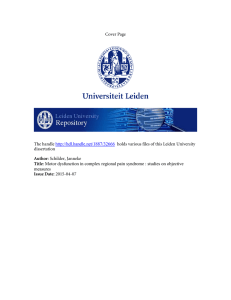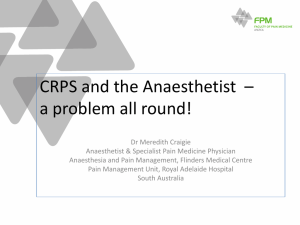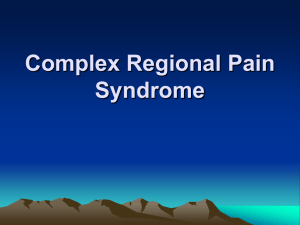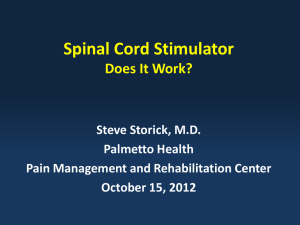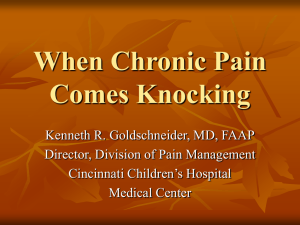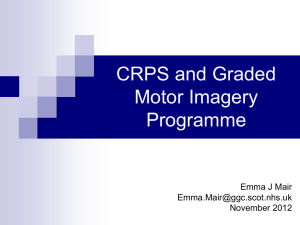Complex Regional Pain Syndrome, Type I and II
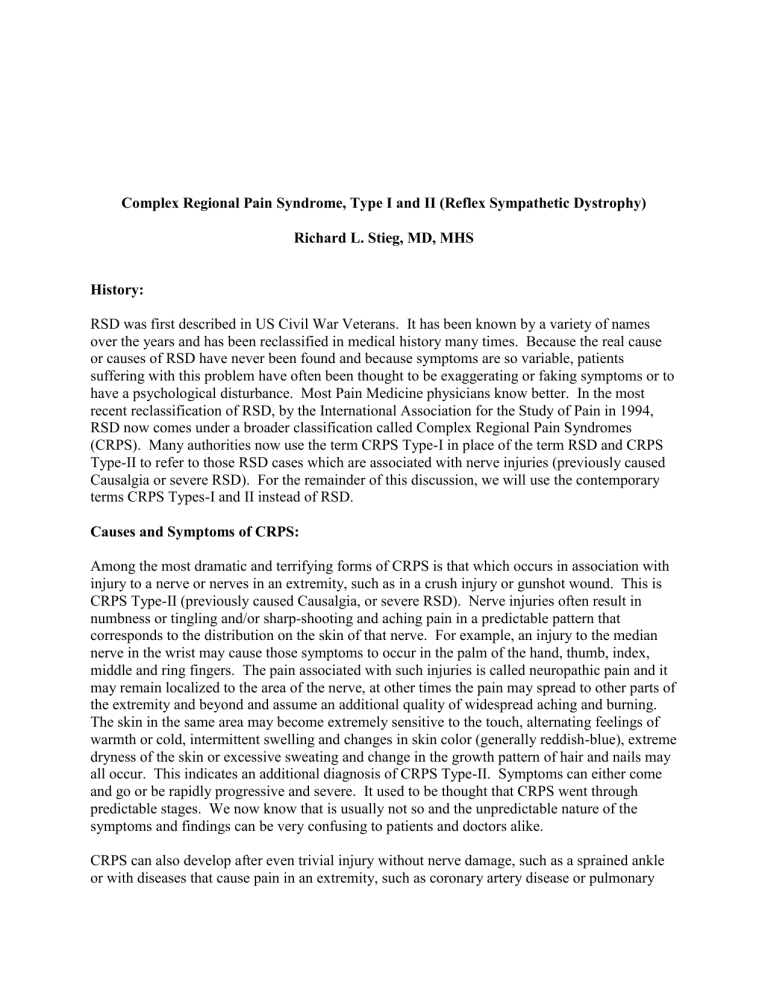
Complex Regional Pain Syndrome, Type I and II (Reflex Sympathetic Dystrophy)
Richard L. Stieg, MD, MHS
History:
RSD was first described in US Civil War Veterans. It has been known by a variety of names over the years and has been reclassified in medical history many times. Because the real cause or causes of RSD have never been found and because symptoms are so variable, patients suffering with this problem have often been thought to be exaggerating or faking symptoms or to have a psychological disturbance. Most Pain Medicine physicians know better. In the most recent reclassification of RSD, by the International Association for the Study of Pain in 1994,
RSD now comes under a broader classification called Complex Regional Pain Syndromes
(CRPS). Many authorities now use the term CRPS Type-I in place of the term RSD and CRPS
Type-II to refer to those RSD cases which are associated with nerve injuries (previously caused
Causalgia or severe RSD). For the remainder of this discussion, we will use the contemporary terms CRPS Types-I and II instead of RSD.
Causes and Symptoms of CRPS:
Among the most dramatic and terrifying forms of CRPS is that which occurs in association with injury to a nerve or nerves in an extremity, such as in a crush injury or gunshot wound. This is
CRPS Type-II (previously caused Causalgia, or severe RSD). Nerve injuries often result in numbness or tingling and/or sharp-shooting and aching pain in a predictable pattern that corresponds to the distribution on the skin of that nerve. For example, an injury to the median nerve in the wrist may cause those symptoms to occur in the palm of the hand, thumb, index, middle and ring fingers. The pain associated with such injuries is called neuropathic pain and it may remain localized to the area of the nerve, at other times the pain may spread to other parts of the extremity and beyond and assume an additional quality of widespread aching and burning.
The skin in the same area may become extremely sensitive to the touch, alternating feelings of warmth or cold, intermittent swelling and changes in skin color (generally reddish-blue), extreme dryness of the skin or excessive sweating and change in the growth pattern of hair and nails may all occur. This indicates an additional diagnosis of CRPS Type-II. Symptoms can either come and go or be rapidly progressive and severe. It used to be thought that CRPS went through predictable stages. We now know that is usually not so and the unpredictable nature of the symptoms and findings can be very confusing to patients and doctors alike.
CRPS can also develop after even trivial injury without nerve damage, such as a sprained ankle or with diseases that cause pain in an extremity, such as coronary artery disease or pulmonary
Page 2 embolus. When there is no known injury to a nerve, the condition is then CRPS Type-I. Like the CRPS Type-II, symptoms are variable and unpredictable, and can become quite severe.
It is unknown whether some individuals are more susceptible than others to develop CRPS.
There is some evidence that people who have had the problem in the past are more prone than others to develop CRPS again with subsequent injuries or medical conditions. Some doctors have suggested that CRPS is a psychological illness. There is no evidence in the medical literature that there are any pre-existing psychological conditions or personality factors involved.
However, as is true of many medical conditions, including asthma and peptic ulcer disease, emotional factors may play a role in the duration and severity of symptoms and response to treatment of CRPS. Those relationships, however, are no more clear to pain specialists than the basic physical changes in the body that cause CRPS.
It is poorly understood why occasional CRPS patients begin to develop similar symptoms in other parts of the body, including other limbs, the trunk, head or face. Other symptoms, such as tremors, muscle wasting and brittleness of bones may also occur. The terms “generalized RSD” or “centralized RSD” have been applied to such cases, which no longer quite fit the description of Complex Regional Pain Syndrome. The cause of these spreading symptoms is unknown.
Many pain specialists prefer the medical term “Pain Disorder” in such cases. That term is much broader and less specific than CRPS and is a reflection of the medical profession’s current ignorance about such cases. We will, nevertheless, use the term “Pain Disorder” in the rest of this discussion when referring to “generalized RSD.”
Making the Diagnosis:
Since the key to treatment is the early recognition of CRPS, the most important issue in diagnosis is that the doctor recognize the warning signs and refer the patient for diagnostic testing. He or she must remember that since symptoms may come and go in the beginning, it is important to remain suspicious until it is clear that CRPS is not the problem. A careful history and neurological sensory examination is the first important diagnostic test. The ability of primary care givers to do this varies considerably. Symptoms and/or signs of CRPS should always trigger other diagnostic tests, or a referral to a recognized pain specialist. There are problems with diagnostic testing, however, which most pain specialists recognize. For example, one of the most controversial, yet useful tests, is an infrared thermogram, which can determine the presence of CRPS in the early stages. This test is “positive” 90% of the time in early CRPS.
However, there are few thermogram laboratories in the US and there is a general distrust among the medical profession about the reliability of the test. That is because in years past, thermograms were often used inappropriately and in the hands of medical charlatans. Another diagnostic test is called selective tissue conductance (STC), which can determine the presence of
Page 3 abnormal sympathetic activity in an extremity. Again, there are few labs in the US that have the equipment to do this testing and interpretation of the results must be put together with history and physical findings by someone who understands CRPS.
Another test is called a bone scan like thermograms and STC, the interpretation of results requires skill and experience. The bone scan may become “positive” in 60% of CRPS patients.
Like the other test, it is quite safe to do, but it often does not help confirm CRPS in the early stages. Therefore, a “negative” bone scan does not mean that CRPS is not present.
Another problem in diagnosis is that if CRPS has been present over a long period of time, and especially if people have been treated for it with sympathetic blocks, signs and symptoms change and diagnostic tests may become negative. This leads to much confusion, especially if the physician is seeing a chronic patient long after symptoms have begun. At this point, the term
Pain Disorder is appropriate, and both diagnosis and treatment are usually quite beyond the scope of expertise and practice of the primary care physician.
Treatment of CRPS:
Although medical science cannot yet agree on the causes of CRPS, certain aspects of proper treatment are well known. The most important of these is that early diagnosis and aggressive treatment with sympathetic blocks (the same ones discussed under “Making the Diagnosis”), along with reactivation of an involved limb (as opposed to splinting or resting) are critical to successful treatment. A natural reaction to pain is to avoid moving a limb and physicians who do not understand CRPS may give this advice. This is the wrong thing to do unless there is an associated problem such as a fracture that leaves the patient no other choice. The frequency and total number of blocks, as well as the types of blocks, are a matter of some debate. Most Pain
Medicine specialists agree that these should be done by properly trained physicians, usually anesthesiologists, and that they should not continue to be used if they do not offer significant pain relief. Without such treatment, most cases of CRPS become worse and chronic
A large number of drugs have been used with varying success. These include painkillers, drugs that affect the sympathetic nervous system, anti-epileptic drugs and steroids. If your doctor is not thoroughly familiar with the dosage ranges, probability of success, potential side effects and drug interactions, you should be referred to someone who is. Drugs are almost never a substitute for early treatment with sympathetic blocks and reactivation, but may become more useful in later or refractory cases.
Many other forms of treatment have been tried for CRPS. These include various kinds of electrical stimulation, biofeedback, acupuncture, hypnosis and numerous others. They are no substitute for early diagnosis and proper treatment, but may be useful in later stages when, unfortunately, sympathetic blocks often may no longer work.
A controversial issue currently is what to do if a surgical approach is being considered for a
CRPS problem associated either with a nerve injury (CRPS-II), or some other source of pain
Page 4 such as a ruptured lumbar disc (CRPS-I). Many patients with CRPS get much worse when there is any further physical damage to an involved limb, including surgical trauma; a few get better.
Many modern Pain Medicine specialists now prefer a combined approach to surgery, coupling sympathetic block at the time of surgery, along with surgical anesthesia. This seems to greatly reduce the risk that surgery will make the CRPS worse.
When patients fall into the category of “Pain Disorder,” treatment is much more difficult. Pain and associated symptoms have sometimes spread to other parts of the body. Muscle pain and tenderness, and emotional distress are very common and add to misery and suffering. The same treatment that can be so effective in the early stages of CRPS may cease to work at all.
Alternative treatments at this stage include:
1.
A team approach coupling physical and (when necessary) psychological rehabilitation under the direction of a Pain Medicine physician and/or:
2.
Chronic use of narcotic drugs, which can either be taken orally or introduced surgically into the area of the spine through the use of a subcutaneous reservoir (the so-called “morphine pump”) and/or:
3.
Direct electrical stimulation of the spinal cord via a surgically implanted stimulator.
All of these treatment measures are expensive and access to specialists who know how to use them is limited.
Roadblocks to Treatment:
Perhaps the biggest roadblock to successful treatment is ignorance about CRPS on the part of a large portion of the medical profession. Patients with suspected symptoms should urge their primary care doctors to refer them to Pain Medicine specialists if they themselves do not understand CRPS or do not suspect that it is a problem. In some cases, patients (including you, the reader) may have read more about the problem than the primary care physician and most specialists.
Another potential roadblock is the unavailability of diagnostic tests or pain specialists due to a clustering of such specialty care in academic centers, large urban areas or parts of the country considered more desirable to live, (such as the sunbelt). In instances where there is limited availability, patients can help their treating doctors by supplying them with information, such as this report, and perhaps prompting referral to distant medical facilities where there are properly trained specialists and specially equipped laboratories.
Another significant roadblock to treatment is the lack of financial resources for CRPS patients.
There are many uninsured or under-insured Americans and this limits access to specialists.
Many medical payment sources including Worker’s Compensation, Personal Injury, Medicare,
Medicaid and general health insurers are themselves ignorant about CRPS and may disapprove tests or treatment simply because they are not familiar with what is reasonable and necessary in
Page 5 this field of medicine. Sadly, some are quite aware of the problem, understand that diagnosing and treating CRPS can be quite expensive. They may take steps to limit their exposure by placing cost controls on diagnostic tests and treatment and/or “transferring risk” to the doctors through managed care contracts. The US Congress, American Medical Association, other medical professional organizations and patient advocacy groups are aware of the problem of access to proper care for people in pain and are looking for solutions. In the meantime, CRPS patients can try to help themselves through self-education, providing their doctor with new information, seeking help through patient advocacy groups and lobbying health care administrators and legislators to protect their rights. Taking responsibility for your own health, as well as that of other CRPS patients can be beneficial and therapeutic.
Where to get Additional Help:
American Academy of Pain Medicine
4700 W. Lake Ave.
Glenview, IL 60025
(847) 375-4731
Website: www.painmed.org
American Pain Society
4700 W. Lake Ave.
Glenview, IL 60025
(847) 375-4715
Website: www.ampainsoc.org
American Chronic Pain Association
PO Box 850
Rocklin, CA 95677
(916) 632-0922
Website: www.theacpa.org
RSD Syndrome Association of America
116 Haddon Ave., Suite D
Haddonfield, NJ 08033
(856) 795-8845
Website: www.rsds.org
DanneMiller Memorial Educational Foundation
Website: www.pain.com
